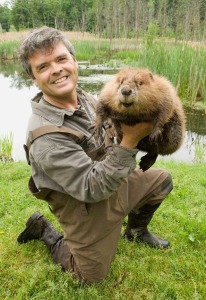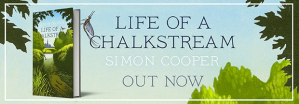Nether Wallop Mill, Hampshire England - Wednesday February 11th 2015
Beavers: good or bad?
I have only once ever seen a beaver; it came trundling past me, appearing out of the early morning mist as we prepared to get into the boat whilst fishing in one of the Wyoming  national parks. What struck me most, aside from the indifference of my boat mate and guide who barely gave it a glance, was its colossal size. Beavers are the hugest of rodents, at forty pounds twice the weight of a badger but really quite docile. This one came past us head down, eager to get wherever he was going, happy to leave us alone if we left him alone. I was genuinely excited, but the other two, natives of Wyoming, could not have been more dismissive at my attempts to engage them in conversation about beavers. "Just wait 'til you see how they live ......" was their only comment.
national parks. What struck me most, aside from the indifference of my boat mate and guide who barely gave it a glance, was its colossal size. Beavers are the hugest of rodents, at forty pounds twice the weight of a badger but really quite docile. This one came past us head down, eager to get wherever he was going, happy to leave us alone if we left him alone. I was genuinely excited, but the other two, natives of Wyoming, could not have been more dismissive at my attempts to engage them in conversation about beavers. "Just wait 'til you see how they live ......" was their only comment.
 national parks. What struck me most, aside from the indifference of my boat mate and guide who barely gave it a glance, was its colossal size. Beavers are the hugest of rodents, at forty pounds twice the weight of a badger but really quite docile. This one came past us head down, eager to get wherever he was going, happy to leave us alone if we left him alone. I was genuinely excited, but the other two, natives of Wyoming, could not have been more dismissive at my attempts to engage them in conversation about beavers. "Just wait 'til you see how they live ......" was their only comment.
national parks. What struck me most, aside from the indifference of my boat mate and guide who barely gave it a glance, was its colossal size. Beavers are the hugest of rodents, at forty pounds twice the weight of a badger but really quite docile. This one came past us head down, eager to get wherever he was going, happy to leave us alone if we left him alone. I was genuinely excited, but the other two, natives of Wyoming, could not have been more dismissive at my attempts to engage them in conversation about beavers. "Just wait 'til you see how they live ......" was their only comment.
Well, beavers do live in amazing places and yes, beaver dams are pretty amazing structures which create great pools for big, lazy cutthroat trout, but boy do they chew their way through a lot of trees. During the day we yomped miles to find the side streams that thread into the Snake River and in so doing passed through hundreds of acres of forest razed to the ground by beavers. It is extraordinary how big a tree they will fell and the landscape, especially where their favourite aspen trees lived, looked like a commercial logging operation had just passed through. In the context of the Grand Teton National Park which is probably about half the size of Wales those acres matter little, but when I read about the Devon beavers and the decision by Natural England to give them the green light I got to wondering how they might fit into the confines of the English landscape.
In the loosest sense of the word beavers are native to Britain; in fact over three millennia ago they were the first river engineers to start damming the rivulets of the chalkstream floodplain that began the long evolution to the rivers we know today. However, docile in Stone Age Britain was no way to survive and the population was extinguished a very long time ago. Fast forward a few thousand years to the start of this millennium and beavers are back with a small population in the Tay valley in Scotland and the Otter valley in Devon. Quite how they got there nobody knows or is admitting, but it was either a deliberate release or they escaped from captivity. Whatever the reason the Tay valley pair has multiplied since 2001 to over a hundred, whereas the Otter valley group, who are of a later vintage, still number a handful.
It is the latter population who caught the headlines last week when Natural England, a government quango that regulates such creatures south of the border, gave permission for the beavers to be allowed to live in the wild and issued a licence for their re-introduction under the care of the Devon Wildlife Trust. It would take too much space to rehearse all the arguments for and against the beavers, but in a nutshell the pro camp sees this as a natural re-introduction with benefits for ecology, flood management and tourism. On the no side disease, habitat destruction and impediments to the free passage of migratory fish are cited. For myself I must admit to having yinged and yanged; initially I thought it was a totally bonkers idea, but then I warmed to the 'yes to beavers' way of thinking until I chanced upon the photo that accompanies this article and the story from Quebec, Canada that goes with it.
In North America beavers are the comeback kids; devastated by trapping and human intervention their numbers a few decades ago had dropped to around a 100,000 across the whole of the continent. But today, with a remarkable reversal of fortune, they number over 20 million thanks to a change in forestry practices and the end of the fur trade. A fur pelt that would have made $500 in the 1940's would now get little more than $20. In Quebec alone the population is over a million, an all time high which has bought with it a whole set of new problems costing government, business and property owners of millions of dollars a year with programmes to stop beavers eating trees where they are needed and sterilisation to stem the population growth. Ironically for the English proponents of beavers the greatest cost is in flood defence and repair. Much though we'd like to think the beavers will build their dams where it will benefit humans they don't; beaver dams are built for beavers which in turn may cause unwanted flooding, in one extreme case washing away a railway line causing a derailment with two deaths.
In truth there may be more nuanced dangers in letting the beavers thrive. We've seen it again and again when species make it into the wild; the American signal crayfish continues to infect and kill our native white claw. The zander, a vicious relative of the pike, has ravaged waterways. The mink helps wipe out swathes of the water vole population. And remember coypu, those furry docile rodents also know as swamp beavers? It took nearly half a century and millions of pounds before they were finally eradicated in 1989 to save the Norfolk Broads from their burrowing destruction. On balance I think Natural England, probably influenced by emotion and a well organised Wildlife Trust, have come to a wrong decision. Of course the beavers will be interesting and novel, but it seems to me that the risks outweigh the benefits and in this case the precautionary principle should prevail with the population removed from the wild.
To read the rest of my Newsletter and receive regular updates visit www.fishingbreaks.co.uk  My recent book Life of a Chalkstream published by William Collins is available from bookshops and Amazon.
My recent book Life of a Chalkstream published by William Collins is available from bookshops and Amazon.
 My recent book Life of a Chalkstream published by William Collins is available from bookshops and Amazon.
My recent book Life of a Chalkstream published by William Collins is available from bookshops and Amazon.
(You won’t, but …)Do yourself a favor and watch the documentary Leave it to Beavers on Prime video.
ReplyDeleteThen get back to me on your opinion.
But you won’t. Because you’re like every other American so stubborn you can’t see past your blinders.
Too bad for you
Let me know if you come to your senses.
ReplyDelete